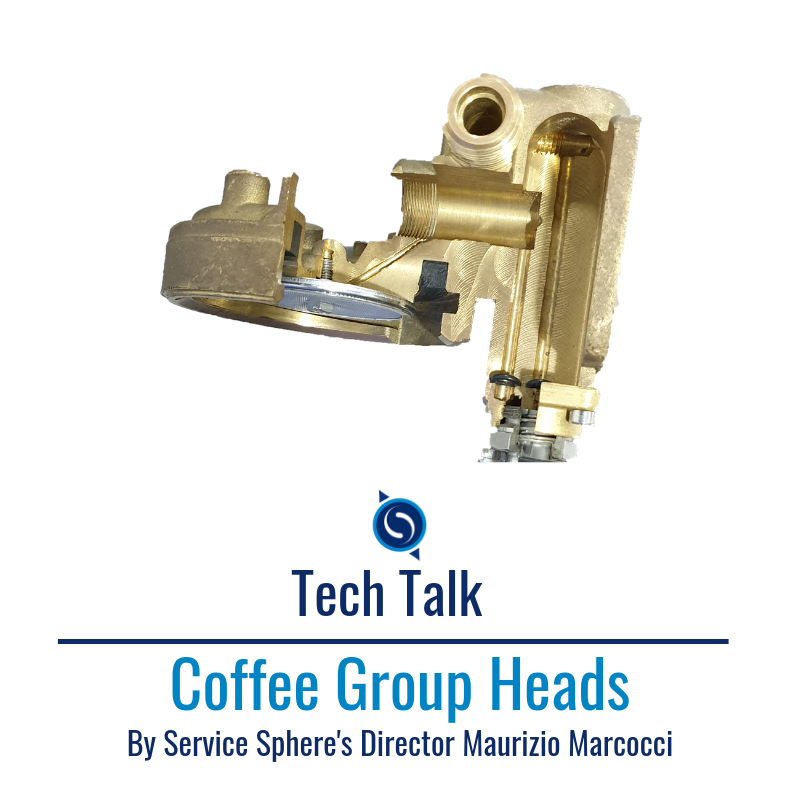Coffee Group Heads
Maurizio Marcocci of Service Sphere discusses the role of the group head, a common espresso machine part that serves a huge purpose.
To pull the best shots possible, baristas need to learn everything they can about coffee extraction. From grind adjustment to water temperature, these factors can all influence the flavour of coffee in the cup. However, while trying to grasp these complex concepts, many baristas can skip over a key component of espresso extraction. Following on from our last tech talk where discussed the huge growth in technological advancements within modern coffee machines, this time we are going back to the basics of an espresso machine and explore the humble coffee group head.
To put it simply, the group head is the part of the espresso machine where water from the boiler is dispensed into the coffee filter basket. It acts as a meeting point, connecting the machine to the group handle and the water to coffee.
The E61, created by Faema, is the most common type of group head found in commercial coffee machines.
How it works
E61 group heads use a thermo-syphon heating system, which sees the coffee machine’s heat exchangers heat water in the boiler. This hot water rises through the group head causing it to heat up. The water will continue to rotate from the heat exchanger to the group head and back to the boiler, causing thermal stability throughout the day. This is known as the thermosyphon system. This system allows for natural pre-infusion of coffee, where a small amount of hot water is applied to the ground coffee at a lower pressure than full extraction pressure. This wets the coffee, allowing the barista to gain full flavour from the blend.
A trip down memory lane
This group head model dates back to the 1960s with Feama’s classic E61. Before this model, manufacturers struggled to make coffee consistent between machines, with group heads of different shapes, designs, and systems producing radically different results.
The E61 became a group head template for manufacturers, each making slight variations on the design to suit their own requirements leading to the introduction of multiple boilers to their machines.
The E61 design is a tried and tested method – and half a century of research and development later, many coffee machine manufacturers still believe it’s a better idea to build on its concept then replace it with something new.
Common misconceptions
At Service Sphere, baristas frequently tell us that the position of a group handle must be at the 90-degree angle for the machine to function correctly, this is not the case. Instead, the further across a handle sits when locked into a group head alerts our technicians that there is either wear in a group seal, group head or handle.
Frequent problems
Most group head issues occur due to a lack of proper maintenance. When machine owners complain about the taste of their coffee, we regularly find dirty group heads and solenoids are the culprit.
Some group heads also use small restriction points to maintain a particular water pressure. If the machine has high amounts of limescale, these points can clog up and limit water flow. If this occurs, we highly recommend you contact your service technician as soon as possible.
There are a few simple things baristas can do day-to-day to minimise these problems from occurring, saving time and money in the long run. Baristas should be backflushing the group heads with a suitable cleaning product once per day. This washes out sticky oils left from ground coffee, which can become lodged within the group head’s components. Another great way to ensure your group head is maintained is to adhere to a comprehensive preventative maintenance program on your espresso machine.
Seals
Ensuring your group head seals are in good condition is important, since a poor seal will lead to leaking in the group head. Overtime, poorly maintained seals become especially troublesome when they need to be replaced, as baristas will try and overtighten the group handles to compensate causing more damage.
Some technicians carry generic ‘packers’ instead of holding specific parts for each brand. When replacing a seal, they simply pack the desired amount, which is usually not to the manufacturer’s specifications. Although they may appear identical it takes only slight width variations to cause a sealing issue.
When a genuine part is available, we do not recommend packers because they can fall out due to a lack of contact with the group head, and not fitting oversized coffee seals. These seals can lead to over tightening of group handles, causing increased wear on the group head.
Another great way we recommend baristas prolong their seals is to leave the group handles locked into the group head when not in use. This is because the seals can become dry overtime without the group handle locked in.
Handles
It’s important to use the correct group handle for your coffee machine. Most group handles are made of a soft metal called brass because of its strong heat conductivity. The trade-off is that it’s a relatively weak metal. What happens is people purchase non genuine group handles made with stainless steel. Although this leads to reduced strain on the group handle, it increases wear to the group head. Ultimately, the switch to stainless steel ensures the longevity of an easily replaceable component at the expense of equipment that is far more expensive and labour intensive to repair.
Simply treating your machine with care instead of jamming in and over tightening the group handle surprisingly will increases the life span of a group head.
Replacing parts
If a group head passes the point of no return, it’s good to know that each part is replaceable. Service Sphere, for instance, stock parts for popular manufacturers, including group heads and handles. However, the real question is it worth getting to this point?
Prices for a basic group head begin around $300 and climb very quickly. The work required to change these parts can require a technician to spend significant time to do this correctly. So yes, it’s replaceable, but would I instead try to ensure the group head doesn’t need replacing? Absolutely.
For more information please visit servicesphere.com.au









